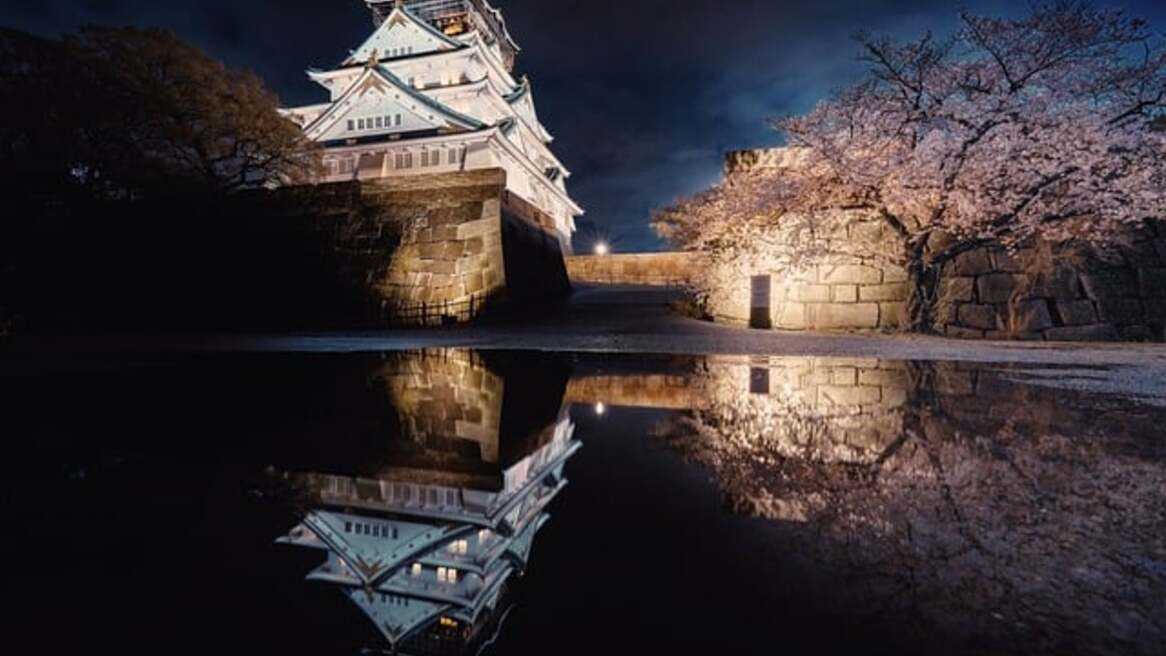 Image by Kanenori from Pixabay
Image by Kanenori from Pixabay
Osaka is grittier, more entrepreneurial and more vibrantly fun-loving than Tokyo. It’s also a much more affordable destination, and the best place in the whole of Japan for a bar crawl. It’s got great food, and great shopping, and a reputation for friendliness. Osaka is a historic destination too. Osaka Castle is one of the most famous landmarks in Japan, a vast, many-roofed building built on two rock platforms, both with moats; the city also has several important shrines, important history museums, art galleries, an aquarium, and an outpost of Universal Studios. Accommodation in the neighbourhoods around the castle, and the older parts of town, is a mix of ryokans, luxury and boutique hotels, and aparthotels. While the downtown neighbourhoods, with their sparkling, contemporary bars, restaurants and shopping precincts, offer more in the line of high tech and contemporary accommodation, including capsule hotels.
 Map of Osaka's official neighb
Map of Osaka's official neighb
Kita, which means ‘north’, is the northern neighbourhood of Osaka, also known as Umeda, because it surrounds Umeda Station. Umeda is a busy station, used for business, commerce, entertainment and travel and this neighbourhood has several major department stores, an expansive network of underground shopping malls connected to the station, and plenty of above-ground accommodation and dining options too. Beyond the station, Kita has a very nice park, the National Museum of Art, the Osaka Museum of Housing and Living, and the Osaka Science Museum – which is much loved by Osaka’s kids. The Umeda Sky Building is another well-advertised Osaka sight – and an ideal spot if you like a fantastic view. To top it off, Kita has nice broad pavements, making it an easy neighbourhood to explore on foot!
Ideal for: A transport hub, shopping, families, easy exploring, business travel
 Image by Arut Thongsombut from
Image by Arut Thongsombut from
Minami is Osaka’s southern neighbourhood, surrounding Namba Station – hence the two names. It offers the same sorts of benefits as Kita when it comes to train travel – it’s an easy hub if you’re wanting to explore both the city and the region beyond. It’s also an easy neighbourhood in which to find places to stay, eat and drink, entertainment, and do some shopping. If you’re interested in nightlife, Minami is a livelier choice than Kita. Aside from shopping and entertainment, Minami is a good neighbourhood for anyone with an interest in seeing kabuki or bunraku performances. It has a wonderful museum of woodblock prints on a theatrical theme too: Kamigata Ukiyoe Museum
Ideal for: City breaks, foodies, party people, shoppers
Dotonbori is a smaller neighbourhood within Minami, well known for its nightlife and neon lights. The neighbourhood expands from the street and canal of the same name, along which there are a myriad of places to eat, drink and make merry. Worth noting are the traditional stone alleyways of Hozenji Yokocho, which are linked with traditional food stalls, cafes and bars, and are a good place to start eating. Shellfish is a speciality, and Dotonbori is a great place to try okonomiyaki and Takoyaki. The area is also a hub for kabuki and bunraku theatre, and has been for the last 400 years or so. Finally, Dotonbori is also home of the huge, neon, Gilco Man — a photo hotspot advertising Japanese snacks!
Ideal for: Night owls, foodies, party people
Discover our recommended hotels in Dotonbori
Explore more >
View all hotels in Dotonbori
Explore more >
Calmer, cheaper, and more central than Kita or Minami, Honmachi is a business district right in between them. This neighbourhood doesn’t offer quite as many accommodation options, or places to eat and drink, but there’s still lots of choice, and it’s an easy walk — or subway ride — from both Kita and Minami. Honmachi isn’t quite as fashionable either, but there are still some chic accommodation options, as well as excellent business hotels, and some very affordable picks too. Honmachi is also a good choice for families: with Utsubo-koen Park and Namba Yasaka-jinja (shrine) very close to Honmachi Station. You can comfortably walk to Osaka Castle if you like the idea of exploring Osaka on foot.
Ideal for: Families, travellers on a budget, explorers
Discover our recommended hotels in Honmachi
Explore more >
View all hotels in Honmachi
Explore more >
Shinsaibashi is a shopping hub, and has been since the Edo period. From high-end boutiques to cool kids fashion care of Japanese youth culture, there’s a hub for it within Shinsaibashi. The heart of the neighbourhood is Shinsaibashi-suji, a 600m long, covered, shopping arcade. This is one of Osaka’s main tourist attractions; there is an impressive array on offer here, including traditional tea shops, woodblock print galleries, and kimono boutiques, and contemporary and upscale fashion brands. There are also plenty of small restaurants and cafes, and a couple of department stores. Come armed with patience for busy crowds, but deep pockets are not essential. Shinsaibashi is a fun place to be in the evening too, especially if you enjoy karaoke. If it's culture you're looking for, Shinsaibashi has a shrine dating from the 8th century, and a beautiful Buddhist temple. Part of the Minami district, this is also a neighbourhood with great transport links, and there’s a varied range of accommodation.
Ideal for: Shoppers, party people
Discover our recommended hotels in Shinsaibashi
Explore more >
View all hotels in Shinsaibashi
Explore more >
 Image by Chamaiporn Kitina fro
Image by Chamaiporn Kitina fro
Osaka-ko or the Osaka Bay Area is Osaka’s waterfront district, with fantastic water views, and one of Japan’s best, and biggest aquariums. There are a couple of different neighbourhoods within the district: Sakishima, which has lots of hotels and restaurants, including some seriously luxurious ones; Tempozan, which is an entertainment neighbourhood, and home to the giant ferris wheel; and Sakurajima Island, which is dominated by Universal Studios Japan.